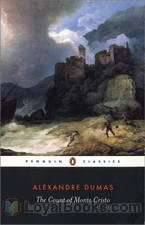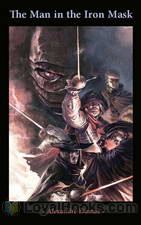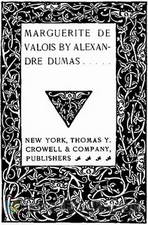|
Books Should Be Free Loyal Books Free Public Domain Audiobooks & eBook Downloads |
|
|
Books Should Be Free Loyal Books Free Public Domain Audiobooks & eBook Downloads |
|
Author Collection |
|---|
By: Alexandre Dumas (1802-1870) | |
|---|---|
 The Count of Monte Cristo
The Count of Monte Cristo
Written by French author Alexandre Dumas, The Count of Monte Cristo follows the life of Edmond Dantes as he embarks on a journey of revenge after being wrongly imprisoned and set up by none other than his so-called friends. Set during the years after the fall of Napoleon’s empire, the story unwinds in several locations including Paris, Marseilles, Rome, Monte Cristo and Constantinople. A handsome young sailor and soon to be ship captain Edmond Dantes seems to have it all in life, as he returns to Marseilles to wed the love of his life and fiancée, the beautiful Mercedes... | |
 The Three Musketeers
The Three Musketeers
The Three Musketeers follows the adventures of the young Gascon nobleman, D’Artagnan and his three trusted friends who served as musketeers in the king’s regiment – Athos, Porthos & Aramis. Written by Alexandre Dumas, the book was a bestseller during the time of its publication and it remains so even today. It follows the timeless theme of friendship and bravery. The main protagonist of the story is D’Artagnan who travels to Paris to realize his dreams of becoming one of the musketeers for the king... | |
 (French) Le Comte de Monte Cristo
(French) Le Comte de Monte Cristo
Edmond Dantès, a young seaman with a promising future, is arrested at his wedding ceremony under calomnious charges, and locked up in the Chateau d’If for 14 years. During this time, he secretly meets another detainee, l’Abbé Faria, an erudite believed to be insane, who becomes his friend and teacher, and who, upon his death, gives Edmond the secret to a hidden treasure. Dantès then manages to escape, almost drowning in the process, and is believed by all to be dead. With the knowledge and the treasure transmitted by l’abbé Faria, and his own wish for revenge, Edmond Dantès plots the downfall of his enemies under the identity of the Count of Monte-Cristo. Summary by Jc Guan. | |
 The Man in the Iron Mask
The Man in the Iron Mask
The Man in the Iron Mask by Alexandre Dumas is part of the novel The Vicomte of Bragelonne: Ten Years After, published in serial form between 1857-50. It is also the last of the D'Artagnan stories written by Dumas and the three musketeers are the real heroes of the story, though the title is given to the man in the iron mask. The story opens with Aramis (one of the musketeers who is now a priest) taking the last confession of a prisoner who is condemned to be executed soon. His confession comes as a thunderbolt to the former musketeer... | |
 (French) Les Trois Mousquetaires
(French) Les Trois Mousquetaires
Le roman raconte les aventures d’un gascon désargenté de 18 ans, d’Artagnan, monté à Paris faire carrière. Il se lie d’amitié avec Athos, Porthos et Aramis, mousquetaires du roi Louis XIII. Ces quatre hommes vont s’opposer au premier ministre, le Cardinal de Richelieu et à ses agents, dont la belle et mystérieuse Milady de Winter, pour sauver l’honneur de la reine de France Anne d’Autriche. Avec ses nombreux combats et ses rebondissements romanesques, Les Trois mousquetaires est l’exemple type du roman de cape et d’épée. (Résumé de Wikipedia) | |
 Twenty Years After
Twenty Years After
First serialized from January to August, 1845, Twenty Years After is the second book in The D’Artagnan Romances, and follows the gallant adventures of the musketeers, as they are once again summoned to alleviate the various threats that lurk in the political scene of France, as the country is threatened by a possible uprising. Enriched with exciting and well-developed characters, the novel adds more detail to its familiar characters, as the musketeers have matured and are portrayed in a more introspective light... | |
 Celebrated Crimes
Celebrated Crimes
Dumas's 'Celebrated Crimes' was not written for children. The novelist has spared no language -- has minced no words -- to describe the violent scenes of a violent time.In some instances facts appear distorted out of their true perspective, and in others the author makes unwarranted charges. The careful, mature reader, for whom the books are intended, will recognize, and allow for, this fact.The first volume comprises the annals of the Borgias and the Cenci. The name of the noted and notorious Florentine family has become a synonym for intrigue and violence, and yet the Borgias have not been without stanch defenders in history... | |
 The Vicomte De Bragelonne
The Vicomte De Bragelonne
After The Three Muskateers and Twenty Years After the adventurous story of Athos, Porthos, Aramis and D'Artagnan continues!The Vicomte of Bragelonne: Ten Years Later (French: Le Vicomte de Bragelonne ou Dix ans plus tard) is the last of the Musketeer novels. It is usually divided into four volumes and this first volume contains chapters 1-75. | |
 The Black Tulip
The Black Tulip
The Black Tulip, written by Alexandre Dumas père and published in 1850, is a historical novel placed in the time of Tulipmania in the Netherlands. The novel begins with the 1672 politically motivated mob lynching of the de Witt brothers and then follows the story of Cornelius van Baerle, godson of Cornelius de Wit. Cornelius Van Baerle has joined the race to breed a truly black tulip – and to win the prize of 100,000 guilders, as well as fame and honour. As he nears his goal he is jailed and then of course rescued – by the beautiful Rosa, daughter of the jailer. | |
 (Dutch) De Drie Musketiers
(Dutch) De Drie Musketiers
De avonturen van een jonge man d'Artagnan, die nadat hij huis en haard verlaten heeft, zich aansluit bij de garde van de koning: de Musketiers. Hij raakt bevriend met het driemanschap Athos, Porthos en Aramis, onafscheidelijke vrienden die leven onder het motto 'Eén voor allen, allen voor één'. | |
 Louise de la Valliere
Louise de la Valliere
After The Three Muskateers and Twenty Years After the adventurous story of Athos, Porthos, Aramis and D'Artagnan continues! The Vicomte of Bragelonne: Ten Years Later (French: Le Vicomte de Bragelonne ou Dix ans plus tard) is the last of the Musketeer novels. It is usually divided into four volumes and this third volume contains chapters 141-208. | |
 (French) La dame aux camélias
(French) La dame aux camélias
| |
 (Spanish) Amaury
(Spanish) Amaury
| |
 (French) Vingt ans après
(French) Vingt ans après
| |
 (French) La reine Margot - Tome I
(French) La reine Margot - Tome I
| |
 Ten Years Later
Ten Years Later
After The Three Muskateers and Twenty Years After the adventurous story of Athos, Porthos, Aramis and D'Artagnan continues!The Vicomte of Bragelonne: Ten Years Later (French: Le Vicomte de Bragelonne ou Dix ans plus tard) is the last of the Musketeer novels. It is usually divided into four volumes and this second volume contains chapters 76-140. | |
 (French) La dame de Monsoreau - Tome 1
(French) La dame de Monsoreau - Tome 1
| |
 (French) Le vicomte de Bragelonne, Tome I
(French) Le vicomte de Bragelonne, Tome I
| |
 (French) Histoire d'un casse-noisette
(French) Histoire d'un casse-noisette
| |
 The Forty-Five Guardsmen
The Forty-Five Guardsmen
| |
 (French) La tulipe noire
(French) La tulipe noire
| |
 (French) Les mille et un fantômes
(French) Les mille et un fantômes
| |
 The Companions of Jehu
The Companions of Jehu
| |
 (French) Le Collier de la Reine, Tome I
(French) Le Collier de la Reine, Tome I
| |
 Marguerite de Valois
Marguerite de Valois
A historical fiction novel set in Paris (1572) during Charles IX's reign and the French Wars of Religion. Marguerite de Valois, daughter of deceased Henry II, is the novel's protagonist set against the infamous schemes of the Catholic power player, Catherine de Medici. | |
 (French) Le Chevalier de Maison-Rouge
(French) Le Chevalier de Maison-Rouge
| |
 Chicot the Jester
Chicot the Jester
This sequel to Dumas' “Marguerite de Valois” begins four years after the sudden death of King Charles IX and succession of his brother Henry III. The reign of King Henry III was plagued with rebellion and political intrigue due to the War of the Three Henries, where his regency was challenged by King Henry of Navarre (leader of the Huguenots) and Henry I, Duke of Guise (leader of the Catholic League). Dumas weaves two main storylines through this turbulent backdrop: one of the love ignited between le Comte de Bussy and la Dame de Monsoreau, and another of the friendship between King Henry III and his truly unique jester, Chicot (Jean-Antoine d'Anglerais). | |
 The Conspirators The Chevalier d'Harmental
The Conspirators The Chevalier d'Harmental
| |
 (French) Georges
(French) Georges
| |
 The Prussian Terror
The Prussian Terror
| |
 (French) Bric-à-brac
(French) Bric-à-brac
| |
 (French) Henri III et sa Cour
(French) Henri III et sa Cour
| |
 (French) Les compagnons de Jéhu
(French) Les compagnons de Jéhu
| |
 (French) La femme au collier de velours
(French) La femme au collier de velours
| |
 (French) Les Femmes qui tuent et les Femmes qui votent
(French) Les Femmes qui tuent et les Femmes qui votent
| |
 (French) Le chevalier d'Harmental
(French) Le chevalier d'Harmental
| |
 (French) Le capitaine Pamphile
(French) Le capitaine Pamphile
| |
 (French) Création et rédemption Deuxième partie: La fille du marquis
(French) Création et rédemption Deuxième partie: La fille du marquis
| |
 (French) Acté
(French) Acté
| |
 The Regent's Daughter
The Regent's Daughter
| |
 (French) Les Quarante-Cinq — Tome 1
(French) Les Quarante-Cinq — Tome 1
| |
 (French) La San-Felice, Tome 01
(French) La San-Felice, Tome 01
| |
 (French) Le Capitaine Aréna — Tome 1
(French) Le Capitaine Aréna — Tome 1
| |
 (French) Le corricolo
(French) Le corricolo
| |
 (French) Création et rédemption Première partie: Le docteur mystérieux
(French) Création et rédemption Première partie: Le docteur mystérieux
| |
 (French) Jacques Ortis; Les fous du docteur Miraglia
(French) Jacques Ortis; Les fous du docteur Miraglia
| |
 The Son of Clemenceau
The Son of Clemenceau
| |
 (French) Le capitaine Paul
(French) Le capitaine Paul
| |
 (French) Le Speronare
(French) Le Speronare
| |
 (Esperanto) La kolomba premio
(Esperanto) La kolomba premio
| |
 d'Artagnan Romances, Vol 3, Part 1: The Vicomte de Bragelonne: Ten Years Later
d'Artagnan Romances, Vol 3, Part 1: The Vicomte de Bragelonne: Ten Years Later
Volume 3 of The d'Artagnan Romances is divided into three parts. The first begins in 1660, ten years after Volume 2, with d’Artagnan as Lieutenant of the King’s Musketeers. In this post, he is very near to achieving his dream and even nearer to his King, being young Louis XIV’s personal guard. Seeing first-hand how powerless the child King was, d’Artagnan resigns his illustrious, but dull, post to turn his sharp wit and sword toward another ambitious aim: restoration of the English monarchy... | |
 d'Artagnan Romances, Vol 2: Twenty Years After (version 2)
d'Artagnan Romances, Vol 2: Twenty Years After (version 2)
Volume 2 of The d'Artagnan Romances begins twenty years after "The Three Musketeers." Since then, d'Artagnan's career has stagnated, he’s lost touch with his friends, and the high favor earned with Queen Anne has been forgotten. His misfortune mirrors that of France, now ruled by an ineffective miser, Cardinal Mazarin, who’s avarice fuels a rebellion. Moreover, England is mired in civil war! Can d’Artagnan do the seemingly impossible: reunite “The Inseparables,” save the Queen and young... | |
 d'Artagnan Romances, Vol 1: The Three Musketeers (version 3)
d'Artagnan Romances, Vol 1: The Three Musketeers (version 3)
The d'Artagnan Romances are six volumes that intertwine exciting events from 17th-century Europe and the life of the most adored French musketeer of that period, Charles de Batz-Castelmore d'Artagnan. Volume 1 introduces d’Artagnan as a young man, seeking to earn the glory of serving in the King’s Musketeers. While in pursuit of this aim, d’Artagnan befriends three musketeers – Athos, Porthos, and Aramis – who aid him in adventures against their King’s adversary, the cunning Cardinal Richelieu. "One for all, and all for one!" - Summary by jvanstan | |
 Celebrated Crimes, Vol. 8: Part 3: The Marquise de Ganges
Celebrated Crimes, Vol. 8: Part 3: The Marquise de Ganges
The assassination of Diane de Joannis de Chateaublanc is a fitting tale to conclude Dumas’ celebrated crimes series. This event was as gruesome as it was brazen and, before the final dagger strokes, both the assassins and the assassinated had become embroiled in high-profile intrigues. As a result, it sent reverberations through common and court societies across Europe for decades. - Summary by jvanstan | |
 Celebrated Crimes, Vol. 8: Part 2: Vaninka
Celebrated Crimes, Vol. 8: Part 2: Vaninka
The story of Vaninka, generally regarded as the most fictionalized of Dumas’ Celebrated Crimes series, occurs during the short and eccentric rule of Emperor Paul I of Russia. Vaninka is a general’s daughter whose love for one of her father’s officers leads to tragic death, savage crimes and perversions of justice. - Summary by jvanstan | |
 Three Musketeers, Version 2
Three Musketeers, Version 2
D’Artagnan, son of a poor Gascon aristocrat, travels to Paris to seek his fortune. His family connections enable him to obtain a position in a Guard regiment. His provincial ingenuousness and his hot-headed sense of honor earn him three duels in as many hours. Thankfully, his preparation with the sword is sufficient to recommend himself to his Musketeer antagonists, and they – Athos, Porthos, and Aramis – become his fast friends. But fate also crosses D’Artagnan’s path with some dangerous people who become his opponents: a mysterious “man from Meung” and a woman who styles herself Milady, who has formidable seduction skills and a heart that is mean and violent... | |
 Celebrated Crimes, Vol. 8: Part 1: The Marquise de Brinvilliers
Celebrated Crimes, Vol. 8: Part 1: The Marquise de Brinvilliers
The crimes of the Marquise of Brinvilliers, a French aristocrat during the reign of Louis XIV, included some of the most famous murders, scandals and mysteries in French history. This story recounts her major crimes, torture, conviction and execution. - Summary by jvanstan | |
 Celebrated Crimes, Vol. 7: Part 3: Murat
Celebrated Crimes, Vol. 7: Part 3: Murat
Amidst the political winds from Napoleon’s downfall, this tale turns our attention to the flight of a former French marshal and King of Naples, Joachim Murat. Murat, unhappy with the deal he made to obtain pardon from the Austrian Emperor, takes a life-ending resolution to retake his crown rather than live in peaceful obscurity. - Summary by jvanstan | |
 Celebrated Crimes, Vol. 7: Part 2: Countess de Saint-Geran
Celebrated Crimes, Vol. 7: Part 2: Countess de Saint-Geran
This story details the crimes and trial surrounding the unexpected pregnancy and subsequent childbirth of the Countess de Saint-Geran in 1640s France. Familial jealousies harbored by her sister-in-law, the Marchioness de Bouille, intertwine with the greedy schemes of a fugitive relative, the Marquis de Saint-Maixent, to produce a scandalous series of events. - Summary by jvanstan | |
 Celebrated Crimes, Vol. 7: Part 1: Ali Pacha
Celebrated Crimes, Vol. 7: Part 1: Ali Pacha
Ali Tepeleni, Pacha of Janina, rose to power during the early 1800s in one of the Ottoman Empire’s most unruly territories . His ferocious imposition of will was limitless, earning him the sobriquet of “the Lion of Janina.” As the mauling and murder of innocents sustains the lion, so did it sustain Ali Pacha’s rule. Thus, the range of celebrated crimes that Dumas describes in this essay are as vast as Ali Pacha’s ambition – an ambition rooted in his mother’s callous advice that “success justified everything, and everything is permissible to him who has the power to do it.” - Summary by jvanstan | |
 Celebrated Crimes, Vol. 6: Part 3: Martin Guerre
Celebrated Crimes, Vol. 6: Part 3: Martin Guerre
Martin Guerre was a French peasant that, during a long absence, was famously impersonated in the 16th century. Although the real Martin Guerre is suspected of no serious crimes, his imposter, Arnaud du Tilh, engaged in fraud and adultery while pursuing false claims to the Guerre inheritance. Dumas later incorporates this celebrated crime into his novel “The Two Dianas.” - Summary by jvanstan | |
 Celebrated Crimes, Vol. 6: Part 2: The Man in the Iron Mask
Celebrated Crimes, Vol. 6: Part 2: The Man in the Iron Mask
In the late 1600s a man was doubly-imprisoned: his body in an iron cell and his face in an iron mask. Who the “man in the iron mask” was, why he was imprisoned, and how he was treated during imprisonment, remains a mystery that has captivated historians for centuries. Before Dumas penned the final volume of his D’Artagnan Romances, “The Man in the Iron Mask,” he wrote that “everything connected with the masked prisoner arouses the most vivid curiosity.” This essay is a comprehensive summary of theories regarding the masked prisoner’s identity and history from the 1770s to Dumas’ time . - Summary by jvanstan | |
 Taking the Bastile
Taking the Bastile
Pitou lost his mother when he was small. He was raised by a stern aunt who did not really love him. He starts knowing the world by going to service. How can this man, Pitou the Peasant go on to influence the whole state? How can he go on and take a part in the French revolution? Can his motivation, coming from what he did not have, be enough? - Summary by Stav Nisser | |
 d'Artagnan Romances, Vol 3, Part 3: The Man in the Iron Mask (version 2)
d'Artagnan Romances, Vol 3, Part 3: The Man in the Iron Mask (version 2)
Volume 3 of The d'Artagnan Romances is divided into three parts. In this, the final part, d’Artagnan’s fortune is near its height; having become the illustrious Captain of the Musketeers, he is now the chief defender of King Louis XIV. Fortune has also smiled on his three companions: Aramis is a wealthy bishop and the powerful, secret Superior General of the Jesuit Order ; Athos is the premier nobleman of France; and Porthos becomes a Duke with the proud but garishly long-winded title of “du Vallon de Bracieux de Pierrefonds... | |
 Marie Antoinette Romances, Vol 1: Balsamo, The Magician
Marie Antoinette Romances, Vol 1: Balsamo, The Magician
This is the first volume of Dumas' Marie Antoinette Romances . This historical fiction chronicles the strange events surrounding the fall of the French monarchy and rise of revolutionaries so terrifying that the period is still called "The Reign of Terrors" . In this volume, a renowned magician, Count Alessandro di Cagliostro , employs various occult tactics, like hypnotism and necromancy, to gain state secrets. Balsamo claims to be plotting against the Bourbons, but one must wonder whether this 3000 year old sorcerer has an ulterior motive... - Summary by jvanstan | |
 Marie Antoinette Romances, Vol 2: The Mesmerist's Victim
Marie Antoinette Romances, Vol 2: The Mesmerist's Victim
This 2nd volume of the Marie Antoinette Romances continues the intrigues of "Balsamo, The Magician" and adds to them the schemes of philosophers and the stirrings of revolution. Balsamo carries on his occult tactics to weaponize the state secrets that he gained in the previous volume. A serious romance and illness takes root in the court of King Louis XV, convincing one of the leading philosophic minds of the era, Jean-Jacques Rousseau, that “the breath of heaven will blast an age and a monarchy.” - Summary by jvanstan | |
 Marie Antoinette Romances, Vol 3: The Queen's Necklace (Version 2)
Marie Antoinette Romances, Vol 3: The Queen's Necklace (Version 2)
This 3rd volume of the Marie Antoinette Romances begins a decade after the close of "The Mesmerist’s Victim” and is based on a real scandal in Louis XVI’s court, commonly called “The Diamond Necklace Affair.” In this volume, the plotting of a powerful occultist, Count Cogliostro , collides with the long-festering resentments of a previous royal house, Jeanne de Valois , a growing popular movement for sociopolitical reform, and a shrinking supply of bread. It is easy to see how converging... | |
 Marie Antoinette Romances, Vol 4: Taking the Bastile
Marie Antoinette Romances, Vol 4: Taking the Bastile
This 4th volume of the Marie Antoinette Romances begins several years after the close of "The Queen’s Necklace.” It describes the events leading up to and including the storming of the Bastile. Past plots of Count Balsamo to destroy the French monarchy are resurrected by the mysterious Dr. Gilbert – a student of Balsamo’s occult arts and the Enlightenment philosopher, Jean-Jacques Rousseau. Considered by many critics to be a highlight of the Marie Antoinette Romances, Dumas tells this quintessential story of the French Revolution through the lens of the people... | |
 Marie Antoinette Romances, Vol 5: The Countess of Charny
Marie Antoinette Romances, Vol 5: The Countess of Charny
This 5th volume of the Marie Antoinette Romances begins after the fall of the Bastille and the March on Versailles, which forced Louis XVI and his court to be escorted back to Paris. In Paris, political factions battle over the fate of the nation, the royal family, and anyone with royalist sympathies. Our heroes and our anti-heroes must navigate the blood-streaked landscape while keeping their necks out of the guillotine. All the while, the prophetic Balsamo urges on the revolution: "the quantity of blood which must be shed before the sun rises on the free world ... | |
 (French) Tulipe noire
(French) Tulipe noire
Si ce titre évoque pour vous un roman de cape et d'épée, détrompez-vous. Mais ne vous détournez pas ! Ce cher Alexandre Dumas saura vous attacher à l'histoire de la tulipe noire et de tous ceux qui s'y intérressent. Résumé par Ezwa If you're expecting a swashbuckler, stand corrected. But don't turn back! Our dear Alexandre Dumas will make you fond of the black tulip and all those around it. Summary by Ezwa | |
 (Spanish) Historia de un cascanueces
(Spanish) Historia de un cascanueces
Alexandre Dumas también se ocupó de la narración infantil con esta versión del clásico cuento de Ernst Theodor Amadeus Hoffman, titulado El Cascanueces y el rey ratón, de 1816. Dumas realizó una adaptación especialmente dirigida a los niños y la publicó en 1844 con el título de Historia de un Cascanueces, que fomentó la imaginación de muchas generaciones de niños y niñas. Fue la versión de Alexandre Dumas la que sirvió a Marius Petipa para concebir en 1892 el ballet El Cascanueces, cuya música fue compuesta por Tchaikovsky. - Summary by Phileas Fogg | |
 (Spanish) Tres Mosqueteros
(Spanish) Tres Mosqueteros
¿Es necesario describir los tres mosqueteros? Advierta el lector que serán más bien cuatro..., pero no adelantemos acontecimientos sin permiso del Rey o, al menos, de la Reina. - Summary by Tux | |
 (Spanish) Vampiro
(Spanish) Vampiro
La dama pálida , aquí traducido como El vampiro, pero también conocido como La bella vampirizada y El vampiro de los Cárpatos, es un relato corto de Alexandre Dumas escrito en 1849 como parte de su recopilación de cuentos de terror Les Mille et un fantômes , se trata de un relato de influencia fantástica y sombría, ambientado en el corazón de los montes Cárpatos y relacionado con vampirismo literario. Este relato está dividido en cuatro partes: Los montes Cárpatos, El castillo de Brankovan, Los dos hermanos y El monasterio de Hango... | |
 (Spanish) mil y un fantasmas, vol. 2
(Spanish) mil y un fantasmas, vol. 2
En este segundo volumen de "Los mil y un fantasmas" Dumas comparte una historia que, en su lecho de muerte le confesó su maestro Carlos Nodier. Tiene como protagonista al escrito de terror E.T.A. Hoffmann y sus aventuras en el París de la Revolución Francesa. "La mujer del collar de terciopelo" se inicia como una turbulenta historia de amor, pero paulatinamente va deslizándose hacia tonos más oscuros y terriblemente espeluznantes ... | |
 (Spanish) Una comida en casa de Rossini
(Spanish) Una comida en casa de Rossini
Dumas concurre a una cena en casa de Rossini el célebre compositor y gran chef italiano. En esa cena se encuentra con otros destacados artistas y se menciona la posibilidad de hacer una obra en conjunto pero de una manera desacostumbrada: se haría primero la música, luego se determinaría la historia y finalmente se redactarían las letras de los actos de la obra musical. El tema a desarrollar entra en discusión ya que se propone una temática, que a priori, no es la deseable para una obra italiana sino para un ambiente más nórdico... | |
 Catherine Howard (Dramatic Reading)
Catherine Howard (Dramatic Reading)
Subtitled "The Throne, The Tomb, and The Scaffold - An Historical Play in 3 Acts From the Celebrated Play of that Name by Alexandre Dumas" - How can you resist a play about English history - the doomed fifth wife of Henry the 8th - by the celebrated French author of The Musketeers?? - Summary by ToddHW Cast list: Henry VIII, King of England: Larry Wilson Athelwold, Duke of Northumberland: Paul Simonin Archbishop Cranmer: alanmapstone Duke of Sussex: KHand Duke of Norfolk: tovarisch Grand Chamberlain:... | |
 Man in the Iron Mask (an Essay)
Man in the Iron Mask (an Essay)
| |
 Count of Monte Cristo (version 2)
Count of Monte Cristo (version 2)
The story takes place in France, Italy, islands in the Mediterranean and the Levant during the historical events of 1815–1838 (from just before the Hundred Days through the reign of Louis-Philippe of France). The historical setting is a fundamental element of the book. It is primarily concerned with themes of justice, vengeance, mercy, and forgiveness, and is told in the style of an adventure story. | |
 Count of Monte Cristo (version 3)
Count of Monte Cristo (version 3)
Le Comte de Monte-Cristo is an adventure novel and one of the author's most popular works. He completed the work in 1844. The story takes place in France, Italy, islands in the Mediterranean and in the Levant during the historical events of 1815-1838 (from just before the Hundred Days to the reign of Louis-Philippe of France). It deals with themes of hope, justice, vengeance, mercy and forgiveness. The book is considered a literary classic today. | |
 Corsican Brothers
Corsican Brothers
Alexandre Dumas weaves the compelling story of Siamese twins who are separated physically but never in spirit. When one of the brothers is murdered, the other leaves Corsica for Paris to avenge the killing. Dumas brings this thrilling tale to life with his fascinating descriptions of Italy and France and his powerful portrayal of the undying love of brother for brother. | |
 Wolf-Leader
Wolf-Leader
Part local legend of a dark and dangerous Wolf-Leader, part childhood memories of his home near Villers-Cotterets, in Aisne, Dumas here penned a chilling supernaturlal encounter between man and the devil. Our hero, Thibault the shoemaker, is beaten on the orders of the Lord of Vez for hunting in the lord's forest. With Thibault's resentment at his treatment by the world at its height, the devil sees his chance and, in the guise of a wolf, proposes a deal which Thibault accepts; the ever available trade of one's soul for evil power... | |
 (French) Histoire d'un casse-noisette
(French) Histoire d'un casse-noisette
Un soir de 24 décembre, Marie et Fritz découvrent, au pied de l'arbre de Noël, un charmant petit bonhomme difforme casseur de noisette. Forcé par de jeunes auditeurs à raconter un conte, Monsieur Dumas nous rapporte ici l'histoire de ce héros improbable, empruntée à Hoffmann. On December's Eve, Marie and Fritz find a charming, though deformed, nut-cracker by the Christmas tree. Forced by a young audience to share a tale, Alexandre Dumas tells the one of this unlikely hero, taking his inspiration from Hoffman. | |
 Celebrated Crimes, Vol. 2: The Massacres of the South
Celebrated Crimes, Vol. 2: The Massacres of the South
Dumas's 'Celebrated Crimes' was not written for children. The novelist has spared no language--has minced no words--to describe the violent scenes of a violent time.In some instances facts appear distorted out of their true perspective, and in others the author makes unwarranted charges. The careful, mature reader, for whom the books are intended, will recognize, and allow for, this fact. | |
 Celebrated Crimes, Vol. 3: Mary Stuart
Celebrated Crimes, Vol. 3: Mary Stuart
The contents of these volumes of 'Celebrated Crimes', as well as the motives which led to their inception, are unique. They are a series of stories based upon historical records, from the pen of Alexandre Dumas, pere, when he was not "the elder," nor yet the author of D'Artagnan or Monte Cristo, but was a rising young dramatist and a lion in the literary set and world of fashion.The third volume is devoted to the story of Mary Queen of Scots, another woman who suffered a violent death, and around whose name an endless controversy has waged... | |
 Forty-Five Guardsmen
Forty-Five Guardsmen
The sequel to "Chicot the Jester" and final book of the "Valois Romances." This story begins six years after the famed "Duel of the Mignons" between the favorites of the courts of King Henry III and Henry the Duke of Guise . Dumas concludes his historical fiction on the War of the Three Henries while detailing the formation of the Forty-Five Guardsmen , following Chicot the Jester as he stays loyal to the failing regency of King Henry III, and continuing the story of Diana . - Summary by jvanstan | |
 Celebrated Crimes, Vol. 4: Karl-Ludwig Sand
Celebrated Crimes, Vol. 4: Karl-Ludwig Sand
This is the fourth volume of Alexandre Dumas' studies of celebrated crimes and their perpetrators. This volume is concerned with the story of Karl Ludwig Sand, who stabbed August von Kotzebue to death in 1819. August von Kotzebue had been a prominent dramatist, a student of Musäus, whose royalist and conservative writings ultimately led to his assassination by a member of a revolutionary liberal Burschenschaft. - Summary by Carolin | |
 Celebrated Crimes, Vol. 4: Part 2: Urbain Grandier
Celebrated Crimes, Vol. 4: Part 2: Urbain Grandier
This is the dramatic story of Urbain Grandier, a catholic priest, who had a reputation to rival that of Casanova, which ultimately led to his destruction. He was accused of witchcraft after a series of accusations from nuns of a nearby convent, who claimed that Grandier has sent several demons upon them. The case is very well documented, and the original documents of the alleged pact, written in backwards Latin and signed by all participating demons, are still preserved. The case continues to inspire art and sciences, leading to assessments of the events in light of modern sociology, psychology, and legal sciences... | |
 Celebrated Crimes, Vol. 1: The Borgias and the Cenci (version 2)
Celebrated Crimes, Vol. 1: The Borgias and the Cenci (version 2)
Dumas's 'Celebrated Crimes' was not written for children. The novelist has spared no language--has minced no words--to describe the violent scenes of a violent time. In some instances facts appear distorted out of their true perspective, and in others the author makes unwarranted charges. The careful, mature reader, for whom the books are intended, will recognize, and allow for, this fact. The first volume comprises the annals of the Borgias and the Cenci. The name of the noted and notorious Florentine family has become a synonym for intrigue and violence, and yet the Borgias have not been without stanch defenders in history... | |
 Celebrated Crimes, Vol. 5: Derues, La Constantin
Celebrated Crimes, Vol. 5: Derues, La Constantin
Dumas, with the assistance of several friends, compiled Celebrated Crimes, an eight-volume collection of essays on famous criminals and crimes from European history. Includes Vaninka and The Marquise De Ganges. - Summary by Michele Eaton | |
 Celebrated Crimes, Vol. 3: Mary Stuart (version 2)
Celebrated Crimes, Vol. 3: Mary Stuart (version 2)
The contents of these volumes of 'Celebrated Crimes', as well as the motives which led to their inception, are unique. They are a series of stories based upon historical records, from the pen of Alexandre Dumas, pere, when he was not "the elder," nor yet the author of D'Artagnan or Monte Cristo, but was a rising young dramatist and a lion in the literary set and world of fashion. The third volume is devoted to the story of Mary Queen of Scots, another woman who suffered a violent death, and around whose name an endless controversy has waged... | |
 Celebrated Crimes, Vol. 4: Karl-Ludwig Sand (version 2)
Celebrated Crimes, Vol. 4: Karl-Ludwig Sand (version 2)
This is the fourth volume of Alexandre Dumas' studies of celebrated crimes and their perpetrators. This volume is concerned with the story of Karl Ludwig Sand, who stabbed August von Kotzebue to death in 1819. August von Kotzebue had been a prominent dramatist, a student of Musäus, whose royalist and conservative writings ultimately led to his assassination by a member of a revolutionary liberal Burschenschaft. - Summary by Carolin | |
 Celebrated Crimes, Vol. 4: Part 2: Urbain Grandier (version 2)
Celebrated Crimes, Vol. 4: Part 2: Urbain Grandier (version 2)
This is the dramatic story of Urbain Grandier, a catholic priest, who had a reputation to rival that of Casanova, which ultimately led to his destruction. He was accused of witchcraft after a series of accusations from nuns of a nearby convent, who claimed that Grandier has sent several demons upon them. The case is very well documented, and the original documents of the alleged pact, written in backwards Latin and signed by all participating demons, are still preserved. The case continues to inspire art and sciences, leading to assessments of the events in light of modern sociology, psychology, and legal sciences... | |
 Paul Jones
Paul Jones
Dumas's play talks of American Naval Hero John Paul Jones's romantic entanglements and affairs of honor ashore in France. He later converted it to a novel. - Summary by ToddHW Cast list: The Marquis D'Auray: Amy Gramour The Marchioness, his wife: Sonia Count Emanuel, their child: Tomas Peter Margaret, their child: Leanne Yau Baron De Lectoure: Nemo Paul Jones: ToddHW Louis Achard: Thomas A. Copeland Mr. De La Jarry: Roger Melin Mr. De Nozay: RecordingPerson Notary: Zames Curran Laffeuille, valet to the Marchioness: Son of the Exiles Jasmin, valet to Emanuel: Eva Davis Stage Directions: Sandra Schmit Edited by: ToddHW | |
 Celebrated Crimes, Vol. 4: Part 3: Nisida
Celebrated Crimes, Vol. 4: Part 3: Nisida
This story details the many crimes surrounding a significant historical confrontation between a fisherman from the island of Nisida, named Gabriel, and the Italian Prince of Brancaleone. Dumas notes that "the details of this case are recorded in the archives of the Criminal Court at Naples." - Summary by jvanstan | |
 Celebrated Crimes, Vol. 5: Part 1: Desrues
Celebrated Crimes, Vol. 5: Part 1: Desrues
This story chronicles the crimes of Antoine-Francois Desrues from his childhood to his execution. Desrues constructed the veneer of a virtuous reputation that hid his ever-increasing deviancy from society. Eventually, his lust for fame and fortune crumbled his virtuous veneer, revealing the startling extent of his crimes, and condemning him to justice by the executioner's hand. - Summary by jvanstan | |
 Celebrated Crimes, Vol. 4: Part 3: Nisida (version 2)
Celebrated Crimes, Vol. 4: Part 3: Nisida (version 2)
Dumas, with the assistance of several friends, compiled Celebrated Crimes, an eight-volume collection of essays on famous criminals and crimes from European history. . This volume tells the story of the infamous prison on Nisida a small island near Naples. - Summary by Michele Eaton | |
 Celebrated Crimes, Vol. 5: Part 2: La Constantin
Celebrated Crimes, Vol. 5: Part 2: La Constantin
Dumas chronicles the court intrigues that led to the execution of Marie La Roux Constantin. La dame Constantin was known by French nobility in the 17th century as the “midwife to the Queen’s daughters.” This title was, in reality, a dark jest as her business was providing dangerous abortions to women ensnared in the machinations of powerful noblemen. This case also highlights how strongly gender inequalities permeated the justice system of this time as reviews by historians, like Dr. Leigh Whaley, found La Constantin was condemned “without any tangible evidence against her.” - Summary by jvanstan | |
 Mademoiselle De Belle Isle
Mademoiselle De Belle Isle
"The refined and fashionable audiences who... used to applaud the play of Mademoiselle de Belle Isle… would, in all probability, have objected to an English version of Dumas' clever play, upon the score of its immorality. It is not for me to determine whether the aristocratic audiences at the St James Theater did not understand what they heard, or whether the French language has a special charm for rendering inoffensive what plain English fails to recommend." - Summary by The Translator Cast list: The... | |
 Celebrated Crimes, Vol. 6: Part 1: Joan of Naples
Celebrated Crimes, Vol. 6: Part 1: Joan of Naples
The celebrated crimes committed during the life of Joan of Naples span from personal misdeeds to regional warfare , and ultimately unraveled her father’s legacy . Dumas projects her story through a deathly lens: beginning with the passing of King Robert the Wise, winding through the untimely demise of nobles, soldiers, and children, then ending at Joan’s own assassination. - Summary by jvanstan | |
 Celebrated Crimes, Vol. 6: Part 2: The Man in the Iron Mask, Martin Guerre
Celebrated Crimes, Vol. 6: Part 2: The Man in the Iron Mask, Martin Guerre
Dumas, with the assistance of several friends, compiled Celebrated Crimes, an eight-volume collection of essays on famous criminals and crimes from European history. Includes The Man in the Iron Mask and Martin Guerre. - Summary by Michele Eaton | |